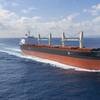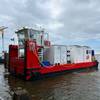Seaway Cargo Shipments Up 17% First Half of Season
Cargo shipments through the St. Lawrence Seaway continue to be buoyed by demand for iron ore and steel slabs with an overall increase of 16.6% year-to-date compared to the same period last year.
The St. Lawrence Seaway reported that marine vessels carried 14.8 million tonnes of cargo from March 25 to July 31 — an increase of over 2 million tonnes compared to the 12.7 million tonnes handled during the same period last year.
Total shipments during the month of July were down 4.8% compared to the same period in 2009 due to lower coal and grain traffic. However, iron ore continued to perform strongly during the month with a 30% increase to 892,000 tonnes. Imports of steel slabs, in the category of break bulk, rebounded to 45,000 tonnes.
Richard Corfe, President and CEO of the St. Lawrence Seaway Management Corporation, said: "As we approach the mid-point of the 2010 navigation season, the year over year increase in tonnage of almost 17 percent is encouraging."
He added: “Robust improvements within the break bulk sector provide reason for cautious optimism for continued strength in shipments for the remainder of 2010. Within the project cargo market, the marine sector remains the transportation mode of choice, as heavy-lift/oversized cargoes can be reliably and safely transported on our waterway.”
This statement was reinforced by the arrival last week at the Port of Duluth of a ship carrying giant wind turbine components destined for Minnesota Power’s Wind Energy Center, which is now under construction near New Salem, North Dakota. Manufactured at a Siemens facility in Brande, Denmark, the equipment was shipped from the port of Aarhus (Denmark).
“The Port of Duluth has handled nearly one million freight tons of wind turbine components in the past five years,” noted Adolph Ojard, executive director of the Duluth Seaway Port Authority. “We’ve begun to see an uptick in wind shipments this year, signaling that sector is starting to rebound. One of the main advantages of the Great Lakes-Seaway System is that we are able to reach 2340 miles into the heartland of North America and deliver these wind turbines as close to the wind resource as possible. Wind power operators and manufacturers are recognizing this benefit.”










